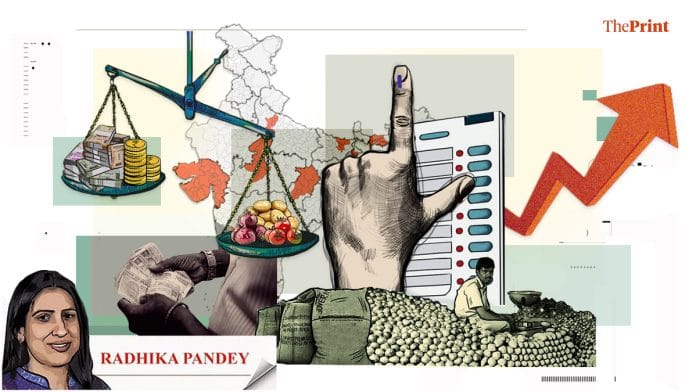Elevated inflation, particularly of food items, is one of the key concerns of the electorate as India is in the midst of the world’s biggest democratic elections. In this article we ask: how have the states going into elections in the third phase fared on inflation in the last financial year?
Of the 10 major states going into elections in the third phase, Bihar, Gujarat, Karnataka, and Uttar Pradesh experienced higher inflation than the all-India average during the financial year 2023-24. In these states, excluding Bihar, inflation in rural areas exceeded their urban counterparts.
In contrast, Assam, Chhattisgarh, Goa, Madhya Pradesh and West Bengal had lower inflation than the all-India figure. Notably, in some of these states, inflation pressures may be building up. Madhya Pradesh and Chhattisgarh saw higher inflation than the national average for the first time in March 2024.
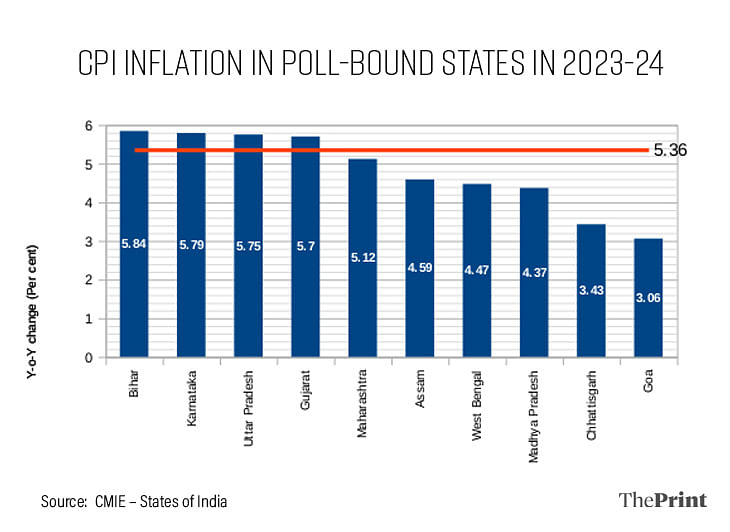
Also read: Central banks on buying spree, strong retail demand — what’s fuelling the big gold price rally
Food inflation in poll-bound states
Five of the 10 states going into polls in the third phase, experienced food inflation higher than the national average. In addition to the above four states, Madhya Pradesh also experienced food inflation higher than the national average in the last financial year. Notably, food inflation in MP is the highest amongst the poll bound states.
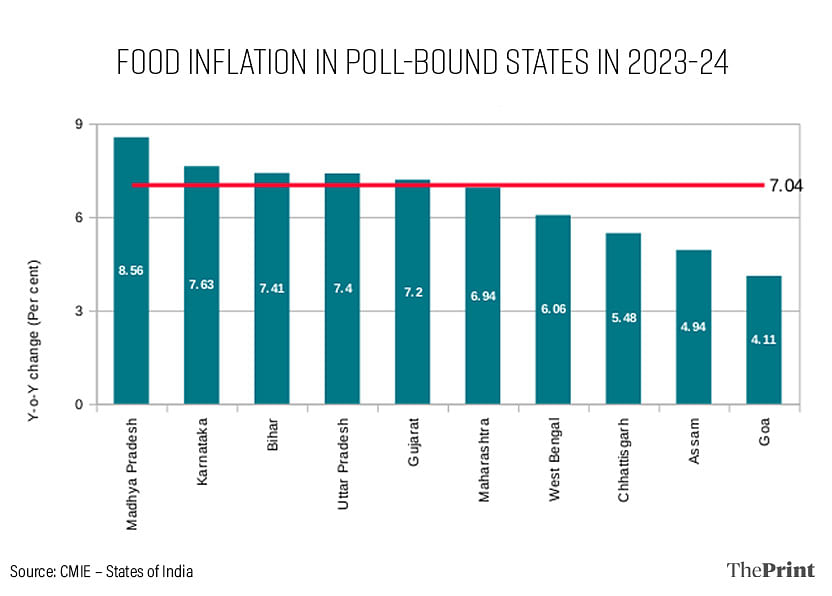
In Karnataka, high inflation is driven by food and fuel price fluctuations. Inflation in cereals, pulses, vegetables and spices was in double-digit in 2023-24, far higher than the levels of 2022-23. The state’s mid-term fiscal plan document, presented alongside the budget, also expressed concerns on the elevated inflation. The report attributed high food inflation to disruptions caused by the 2023 monsoon season, which negatively impacted the agricultural output, and contributed to rising food costs and inflation pressures in the state.
Monsoon disruption impacted 48 lakh hectare of sowing area, lending an upward pressure to food prices. To ease this last year, the state government launched the Anna Bhagya scheme which provides 10 kg of rice per capita per month for all BPL card holders, of which 5 kg is supplied by the central government under the National Food Security Act.
Lower than expected pulses yields in key producer states
Among the poll-bound states, Maharashtra, Karnataka, Gujarat and Madhya Pradesh are the key pulses procuring states. Deficient rainfall in these states resulted in rise in pulses prices. In Gujarat, for instance, while cereal inflation in 2023-24 was lower than last year, pulses inflation increased from 3.4 percent in 2022-23 to more than 17 percent in 2023-24. Similarly in Madhya Pradesh, inflation in pulses rose from 1.9 percent in 2022-23 to 21 percent in 2023-24.
Due to a shortfall in supply, imports of pulses have almost doubled in 2023-24 to USD 3.74 billion. Despite measures by the government like higher minimum support prices (MSP), domestic production of pulses has taken a hit due to erratic climate conditions.
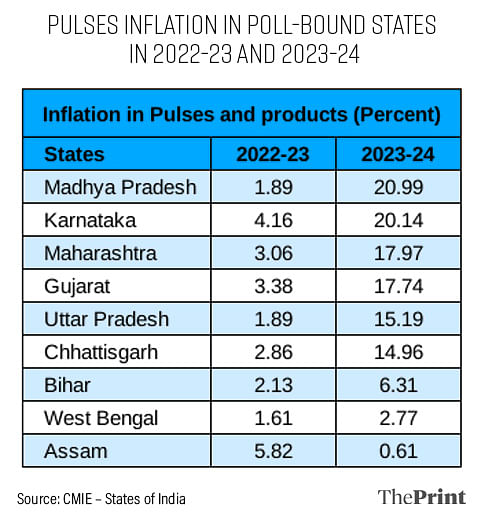
An alternative way is to look at the average price and arrival of commodities in the markets of key producer states. For arhar dal, for instance, the average monthly price in the Mumbai market has risen in FY 2023-24 as compared to the previous year and arrival of Arhar dal crop has been volatile, reflecting supply shortages.
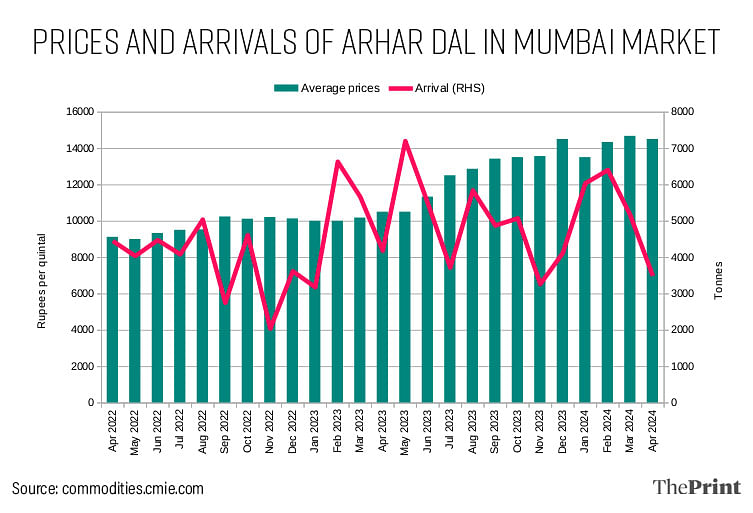
Uneven rains and heat have altered seasonal pattern in vegetable inflation
Weather induced supply shocks kept vegetable prices high in FY 2023-24. Vegetable prices typically see a surge in summer and ease in winters due to arrival of fresh stocks in the market. Last year, during the summer months, the vegetable price index rose much more than the typical seasonal uptick and the easing trend was not visible in the winter of 2023-24. The abnormally high prices during summer months and absence of the seasonal dip in prices during the winter months was visible for most of the poll-bound states experiencing high food inflation.
A simple comparison of CPI Vegetables for previous years and FY 2023-24 shows that the index numbers in the latter were significantly higher. Figure below shows a comparison of CPI vegetables for Maharashtra.
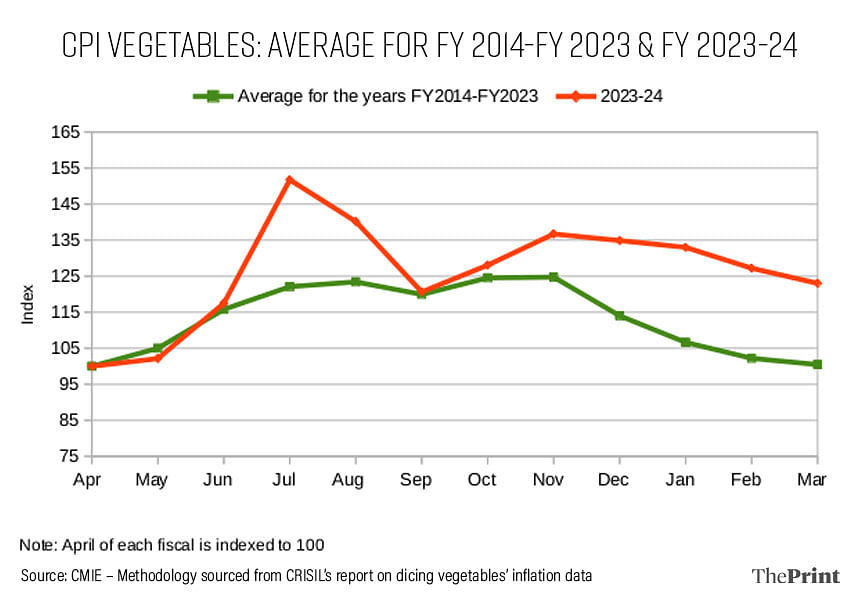
While high prices of tomatoes and onions made headlines, prices of other vegetables like ginger, garlic, and brinjal also witnessed unprecedented surge in 2023-24. In Madhya Pradesh, the unseasonal rains damaged the garlic crop, resulting in price shooting up to Rs 300 per kg.
Food inflation in states with a higher weightage of food
Higher food inflation will have a particularly adverse impact on those states where food commands a higher weight in the overall consumption basket. Food occupies almost 61 percent weightage in consumption pattern in rural Bihar. Cereals and vegetables are the two biggest constituents of the food basket with a share of almost 27 percent.
While inflation in pulses was comparatively moderate in Bihar, cereals inflation at 17 percent and vegetable inflation at more than 17 percent pinched households’ budget.
Urban-rural gap in inflation is stark for some states
Chhattisgarh has managed to keep inflation at 3.4 percent, which is below the all-India average in 2023-24. Even food inflation is lower than the all-India average. Oddly, however, urban food inflation in the state is almost 3.5 percentage points higher than the rural inflation. Chhattisgarh is one of the few states with a relatively lower cereal inflation but inflation in pulses and vegetables is a cause of concern. Again, the urban inflation in these categories exceeds the rural inflation by a margin of 6-7 percentage points.
In summary, even though some of the poll-bound states are the top producers of pulses, cereals, onions and tomatoes, they witnessed major swings in prices in FY 2023-24. The policy priority for the new government in each of these producer states would be to curb the volatile swings in prices through better storage facilities and through improvement in agriculture infrastructure. The wide gap between rural and urban inflation in some states could be an indication of supply side bottlenecks and should be an area of attention for the state governments.
Radhika Pandey is associate professor and Rachna Sharma is a Fellow at National Institute of Public Finance and Policy.
Views are personal.
Also read: India set to grow faster than expected, but geopolitical tensions, inflation & global debt loom



